Kindergarten Abbreviations: Key Acronyms

Written by
Ernest Bio Bogore

Reviewed by
Ibrahim Litinine
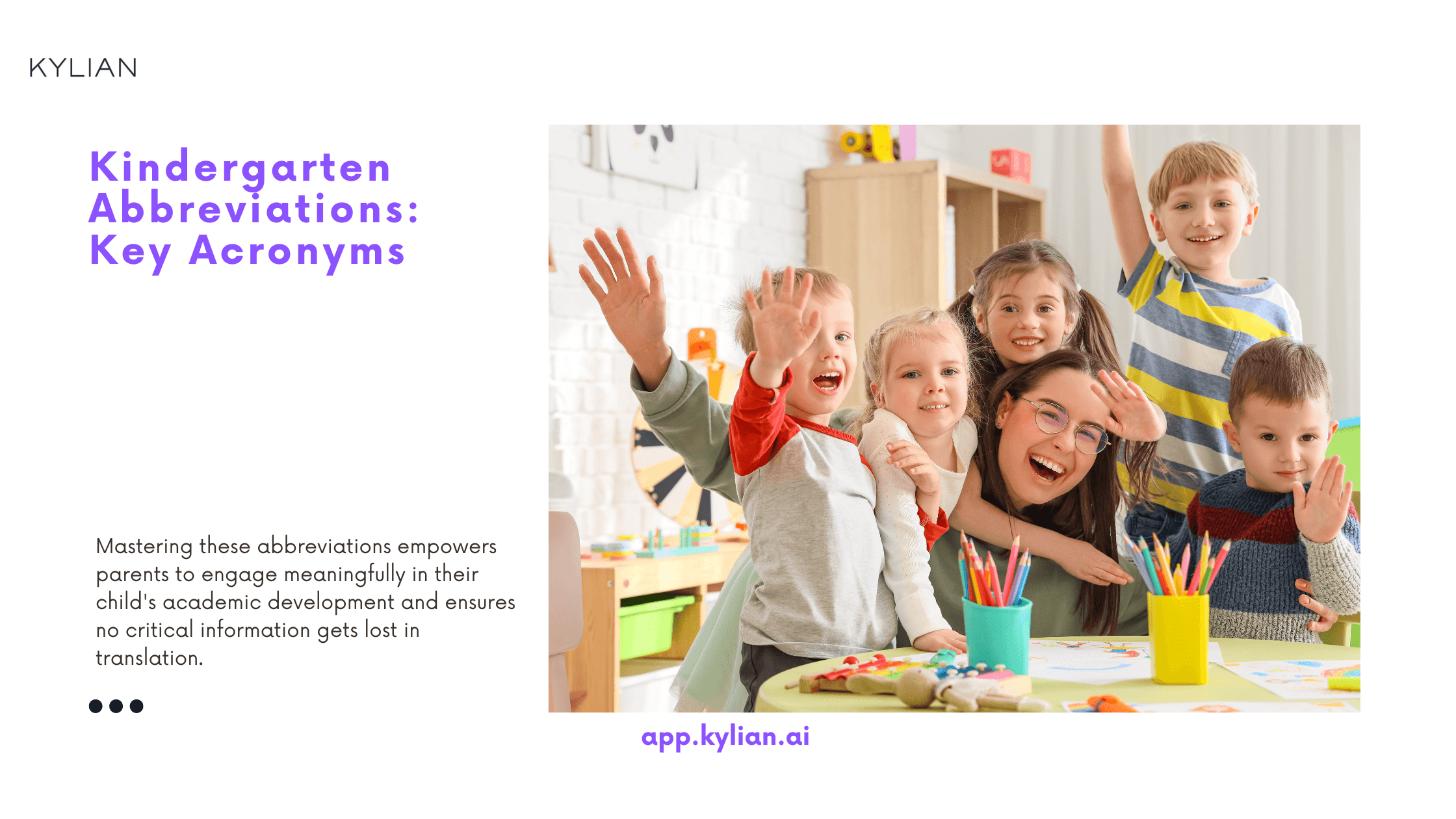
Parents navigating their child's educational journey encounter countless abbreviations. From IEP to ESL, these acronyms can overwhelm even the most prepared families. Understanding kindergarten abbreviations becomes crucial when communicating with teachers, reviewing assessment reports, or advocating for your child's needs.
Educational terminology has evolved significantly, with specialized programs and interventions now standard practice. Mastering these abbreviations empowers parents to engage meaningfully in their child's academic development and ensures no critical information gets lost in translation.
Essential Everyday Kindergarten Abbreviations
The foundation of kindergarten communication relies on understanding basic educational acronyms that appear in daily interactions, progress reports, and school correspondence. These abbreviations form the backbone of educational documentation and parent-teacher conversations.
K stands for Kindergarten itself, the foundational year of formal education. This abbreviation appears consistently across enrollment forms, grade level designations, and academic records. Teachers use "K" when discussing grade-level expectations, curriculum standards, and developmental milestones specific to five and six-year-old learners.
PK represents Pre-Kindergarten, the preparatory year preceding kindergarten entry. Many districts use PK to distinguish between traditional kindergarten and preparatory programs designed for younger children or those needing additional developmental support before entering formal kindergarten.
RTI means Response to Intervention, a multi-tiered approach supporting struggling learners through increasingly intensive interventions. RTI documentation becomes particularly relevant when children demonstrate academic or behavioral challenges requiring systematic support beyond typical classroom instruction.
IEP stands for Individualized Education Program, a legally binding document outlining specialized instruction for children with identified disabilities. IEP meetings involve parents, teachers, and specialists collaborating to establish annual goals, accommodations, and services ensuring appropriate education for children with special needs.
504 refers to Section 504 of the Rehabilitation Act, providing accommodations for children with disabilities that don't qualify for special education services. Unlike IEPs, 504 plans focus on removing barriers to learning through environmental modifications rather than specialized instruction.
The frequency of these abbreviations in kindergarten settings reflects their fundamental importance in educational planning and communication. Parents encounter these terms during enrollment, assessment discussions, and intervention planning meetings.
Academic Assessment Abbreviations in Kindergarten
Assessment terminology in kindergarten involves specialized abbreviations that measure developmental progress across multiple domains. Understanding these acronyms helps parents interpret evaluation results and participate effectively in educational planning discussions.
DIBELS stands for Dynamic Indicators of Basic Early Literacy Skills, a standardized assessment measuring reading fluency and comprehension development. DIBELS scores provide quantitative data about phonemic awareness, alphabetic principle understanding, and reading accuracy that inform instructional decisions.
PBIS represents Positive Behavioral Interventions and Supports, a framework promoting positive school climate through evidence-based behavioral strategies. PBIS implementation in kindergarten focuses on teaching appropriate behaviors rather than simply responding to inappropriate ones.
CBM means Curriculum-Based Measurement, frequent assessment tools monitoring student progress toward specific academic goals. CBM data collection occurs regularly, providing timely feedback about instructional effectiveness and student growth patterns.
AIMSweb is a comprehensive RTI and multi-tiered system of supports platform that combines universal screening, progress monitoring, and data management. AIMSweb assessments help identify students needing additional support and track intervention effectiveness over time.
STAR stands for Standardized Test for the Assessment of Reading, a computer-adaptive assessment measuring reading comprehension and vocabulary development. STAR scores provide grade-level equivalents and percentile rankings comparing individual performance to national norms.
These assessment abbreviations appear frequently in kindergarten documentation because early identification of learning difficulties significantly improves long-term academic outcomes. Research demonstrates that interventions implemented during kindergarten prove more effective than remediation efforts initiated in later grades.
Special Education and Support Service Abbreviations
Special education services in kindergarten utilize numerous abbreviations representing various professionals, programs, and intervention strategies. These acronyms become particularly important for families navigating special needs support systems.
FAPE stands for Free Appropriate Public Education, the legal guarantee ensuring children with disabilities receive individualized instruction at no cost to families. FAPE requirements drive IEP development and service provision decisions throughout a child's educational career.
LRE means Least Restrictive Environment, the principle requiring children with disabilities to learn alongside typically developing peers to the maximum extent appropriate. LRE determinations influence classroom placement decisions and service delivery models.
OT represents Occupational Therapy, specialized services addressing fine motor skills, sensory processing, and functional daily living skills. Kindergarten OT services often focus on handwriting readiness, scissors skills, and sensory regulation strategies.
PT stands for Physical Therapy, services targeting gross motor development, mobility, and physical function. PT support in kindergarten typically addresses balance, coordination, and movement skills necessary for playground participation and classroom activities.
SLP means Speech-Language Pathologist, professionals addressing communication disorders including articulation, language development, and social communication skills. SLP services in kindergarten often target phonological awareness, vocabulary development, and conversational skills.
APE represents Adapted Physical Education, specialized instruction modifying physical education activities for children with disabilities. APE services ensure students with physical limitations can participate meaningfully in movement and fitness activities.
The intersection of these services requires careful coordination to avoid overwhelming young learners while addressing their comprehensive needs. Effective special education teams communicate regularly using these abbreviations to streamline service delivery and maintain consistency across interventions.
Behavioral and Social-Emotional Learning Abbreviations
Kindergarten behavioral support systems employ specific abbreviations representing evidence-based interventions and social-emotional learning frameworks. These acronyms reflect the increasing recognition of behavioral and emotional factors in academic success.
SEL stands for Social-Emotional Learning, curriculum addressing self-awareness, self-management, social awareness, relationship skills, and responsible decision-making. SEL implementation in kindergarten establishes foundational skills for emotional regulation and positive peer interactions.
MTSS means Multi-Tiered System of Supports, a comprehensive framework integrating academic and behavioral interventions across three tiers of increasing intensity. MTSS approaches address the whole child through coordinated support systems.
BIP represents Behavior Intervention Plan, a formal document outlining strategies for addressing challenging behaviors through positive supports and environmental modifications. BIP development follows functional behavioral assessment completion and focuses on teaching replacement behaviors.
FBA stands for Functional Behavioral Assessment, a systematic process identifying the purpose or function of challenging behaviors. FBA results inform BIP development by determining what triggers and maintains problematic behaviors.
SWPBS means School-Wide Positive Behavioral Supports, a systems-level approach establishing consistent behavioral expectations and recognition systems throughout the school environment. SWPBS implementation creates predictable structures supporting all students' behavioral success.
Behavioral abbreviations in kindergarten reflect developmental understanding that young children require explicit instruction in social skills and emotional regulation. Early intervention in behavioral areas prevents more serious difficulties from developing in subsequent grades.
Technology and Digital Learning Abbreviations
Modern kindergarten classrooms integrate technology requiring familiarity with digital learning abbreviations. These acronyms represent platforms, devices, and instructional approaches increasingly common in elementary education.
LMS stands for Learning Management System, digital platforms organizing curriculum content, assignments, and communication between teachers, students, and families. Popular kindergarten LMS options include Google Classroom, Seesaw, and Canvas.
BYOD means Bring Your Own Device, policies allowing students to use personal technology for educational purposes. BYOD implementation in kindergarten typically involves tablets or smartphones for specific learning activities rather than comprehensive device integration.
AR represents Augmented Reality, technology overlaying digital information onto real-world environments. AR applications in kindergarten might include interactive books, virtual field trips, or manipulative math activities enhancing traditional instruction.
QR stands for Quick Response codes, scannable images linking to digital content or activities. Kindergarten teachers use QR codes for listening centers, parent communication, or independent practice activities.
STEM means Science, Technology, Engineering, and Mathematics, integrated approach to learning emphasizing problem-solving and critical thinking skills. STEM activities in kindergarten often involve hands-on exploration and basic coding concepts.
Technology abbreviations in kindergarten education reflect broader shifts toward digital literacy development beginning in early childhood. However, research emphasizes that technology should supplement rather than replace hands-on, experiential learning opportunities appropriate for young children's developmental needs.
Communication and Documentation Abbreviations
Kindergarten communication systems rely on abbreviations streamlining documentation, progress reporting, and parent correspondence. Understanding these acronyms helps families navigate school communication effectively.
FERPA stands for Family Educational Rights and Privacy Act, federal legislation protecting student education records confidentiality. FERPA compliance affects how schools share information about children's academic progress and behavioral concerns.
COPPA means Children's Online Privacy Protection Act, regulations governing collection of personal information from children under 13. COPPA requirements influence digital platform selection and parental consent procedures for online learning tools.
ESY represents Extended School Year services, specialized instruction provided during summer months for children with disabilities who would experience significant regression without continuous programming. ESY determination follows specific criteria outlined in federal special education law.
PWN stands for Prior Written Notice, documentation provided to parents before schools propose or refuse to initiate, change, or discontinue special education services. PWN requirements ensure parents receive adequate information about educational decisions affecting their children.
The proliferation of educational abbreviations reflects increased specialization and regulatory requirements in kindergarten education. While these acronyms facilitate professional communication, they can create barriers for families unfamiliar with educational terminology.
Cultural Context of Educational Abbreviations
Educational abbreviations serve multiple functions beyond simple communication efficiency. They represent professional identity, expertise, and membership in specialized communities of practice. However, this insider language can inadvertently exclude parents and families from meaningful participation in educational decision-making.
The rapid expansion of educational acronyms reflects broader trends toward specialization and accountability in public education. Federal legislation including No Child Left Behind and Every Student Succeeds Act has generated numerous compliance requirements, each with associated abbreviations and documentation procedures.
Research indicates that educational jargon, including abbreviations, can inhibit effective parent-school communication. Families from diverse linguistic and cultural backgrounds may feel particularly intimidated by unfamiliar terminology, potentially reducing their engagement in their children's education.
Effective educators recognize the potential barrier created by excessive abbreviation use and intentionally explain terminology during parent interactions. This practice demonstrates respect for families' perspectives while ensuring clear communication about children's educational needs and progress.
Professional Development and Training Abbreviations
Kindergarten educators engage in ongoing professional development using specific abbreviations representing certification programs, training requirements, and specialized credentials. These acronyms reflect the complex preparation necessary for effective early childhood education.
CDA stands for Child Development Associate, a national credential recognizing competency in early childhood education. CDA certification requires formal coursework, practical experience, and portfolio documentation demonstrating effective teaching practices.
NAEYC means National Association for the Education of Young Children, the leading professional organization establishing standards for early childhood programs. NAEYC accreditation represents high-quality programming meeting rigorous criteria for curriculum, teacher qualifications, and family engagement.
DAP represents Developmentally Appropriate Practice, teaching strategies aligned with children's developmental characteristics, individual differences, and cultural backgrounds. DAP implementation requires understanding of child development principles and culturally responsive pedagogy.
PLC stands for Professional Learning Community, collaborative groups of educators focused on improving student learning through shared inquiry and collective responsibility. PLC participation allows kindergarten teachers to examine student data and refine instructional practices collaboratively.
Professional development abbreviations highlight the specialized knowledge base required for effective kindergarten instruction. Early childhood education combines child development expertise, content knowledge, and pedagogical skills in ways distinct from other educational levels.
Administrative and Policy Abbreviations
Kindergarten programs operate within complex administrative and policy frameworks using numerous abbreviations representing regulations, funding sources, and organizational structures. These acronyms affect program implementation and resource allocation decisions.
ESSA stands for Every Student Succeeds Act, federal legislation governing education policy including accountability requirements, teacher qualifications, and student assessment mandates. ESSA compliance affects kindergarten programming through data collection and reporting requirements.
Title I represents federal funding supporting schools serving high percentages of students from low-income families. Title I resources in kindergarten often support additional reading instruction, family engagement activities, and professional development opportunities.
LEA means Local Education Agency, the district-level organization responsible for implementing state and federal education requirements. LEA policies determine kindergarten program structure, curriculum adoption, and assessment procedures.
ADA stands for Americans with Disabilities Act, civil rights legislation prohibiting discrimination based on disability status. ADA compliance affects school facility design, program accessibility, and service provision for children with disabilities.
Administrative abbreviations reflect the complex regulatory environment surrounding kindergarten education. While these requirements aim to ensure equity and quality, they also create compliance burdens that can divert resources from direct instruction and student support.
Kindergarten Abbreviations FAQ
What does RTI mean in kindergarten?
RTI stands for Response to Intervention, a framework providing systematic support for struggling learners through increasingly intensive interventions. In kindergarten, RTI typically begins with high-quality classroom instruction (Tier 1), progresses to targeted small-group intervention (Tier 2), and may advance to intensive individualized support (Tier 3) based on student response to previous interventions.
How do IEP and 504 plans differ in kindergarten?
IEP (Individualized Education Program) serves children with identified disabilities requiring specialized instruction, while 504 plans provide accommodations for children with disabilities who can access general education curriculum with modifications. IEPs involve specialized teaching methods and measurable goals, whereas 504 plans focus on removing barriers through environmental changes and supports.
What assessment abbreviations should kindergarten parents know?
Key assessment abbreviations include DIBELS (reading skills measurement), PBIS (behavioral support framework), CBM (progress monitoring), and STAR (standardized reading assessment). These tools help teachers identify learning needs, monitor progress, and adjust instruction based on individual student performance data.
Why are there so many abbreviations in kindergarten education?
Educational abbreviations reflect increased specialization, federal compliance requirements, and professional communication efficiency. While abbreviations streamline professional discourse, they can create barriers for parent understanding and engagement in their children's education.
How can parents better understand kindergarten abbreviations?
Parents should request explanation of unfamiliar abbreviations during school meetings, maintain an abbreviation reference list, and advocate for clear communication from school personnel. Many schools provide glossaries of common educational terms, and parents have the right to receive information in understandable language.
What technology abbreviations appear in kindergarten?
Common technology abbreviations include LMS (Learning Management System), BYOD (Bring Your Own Device), AR (Augmented Reality), QR (Quick Response codes), and STEM (Science, Technology, Engineering, Mathematics). These reflect increasing integration of digital tools in early childhood education while maintaining developmentally appropriate practices.
Understanding kindergarten abbreviations empowers parents to navigate educational systems effectively and advocate for their children's needs. While these acronyms can seem overwhelming initially, familiarity with common abbreviations enables meaningful participation in educational planning and decision-making processes. The key lies in recognizing that behind every abbreviation stands a person, program, or principle designed to support children's learning and development during this critical educational foundation year.
Learn Any Language with Kylian AI
Private language lessons are expensive. Paying between 15 and 50 euros per lesson isn’t realistic for most people—especially when dozens of sessions are needed to see real progress.
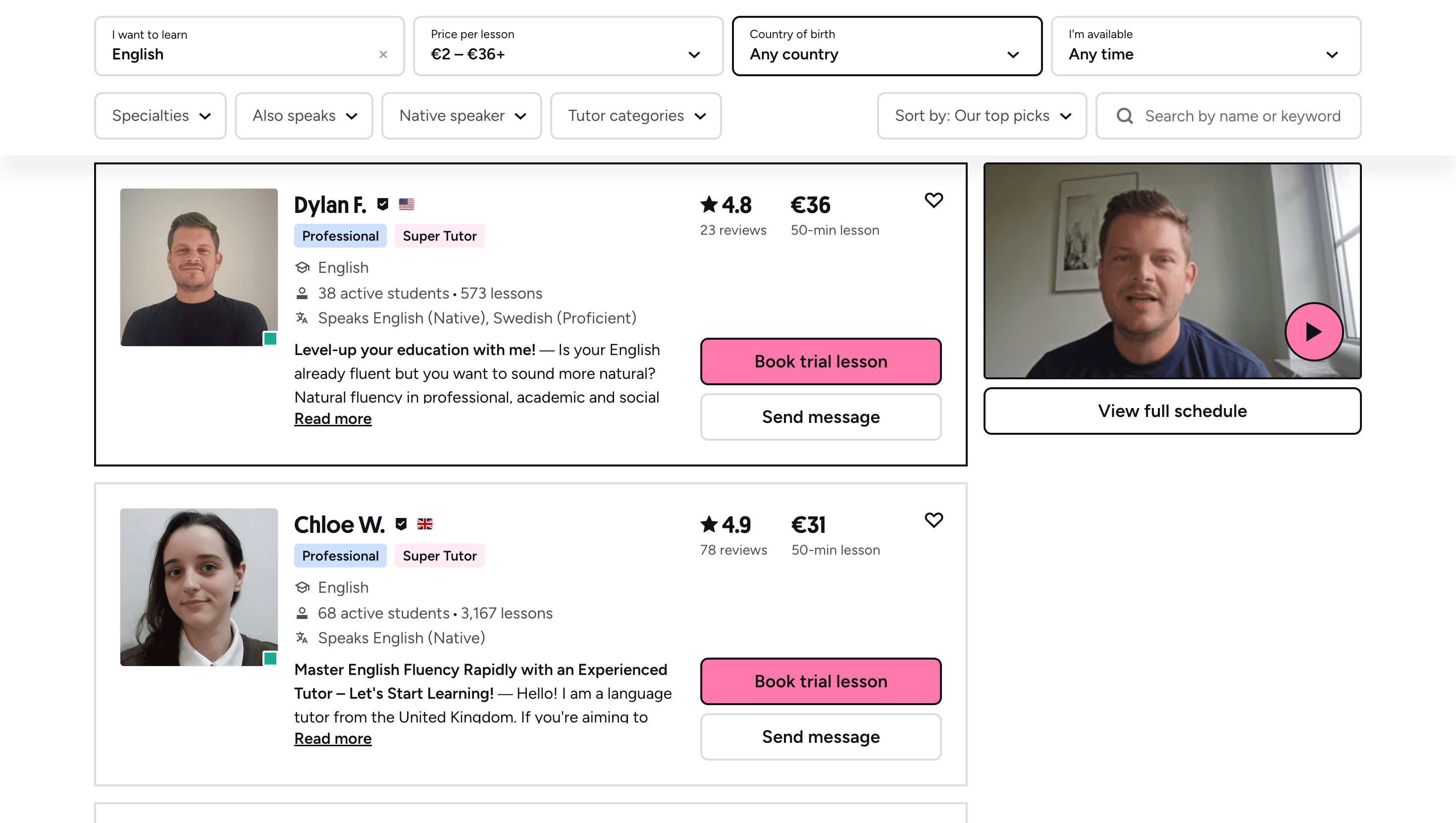
Many learners give up on language learning due to these high costs, missing out on valuable professional and personal opportunities.
That’s why we created Kylian: to make language learning accessible to everyone and help people master a foreign language without breaking the bank.
To get started, just tell Kylian which language you want to learn and what your native language is
Tired of teachers who don’t understand your specific struggles as a French speaker? Kylian’s advantage lies in its ability to teach any language using your native tongue as the foundation.
Unlike generic apps that offer the same content to everyone, Kylian explains concepts in your native language (French) and switches to the target language when necessary—perfectly adapting to your level and needs.
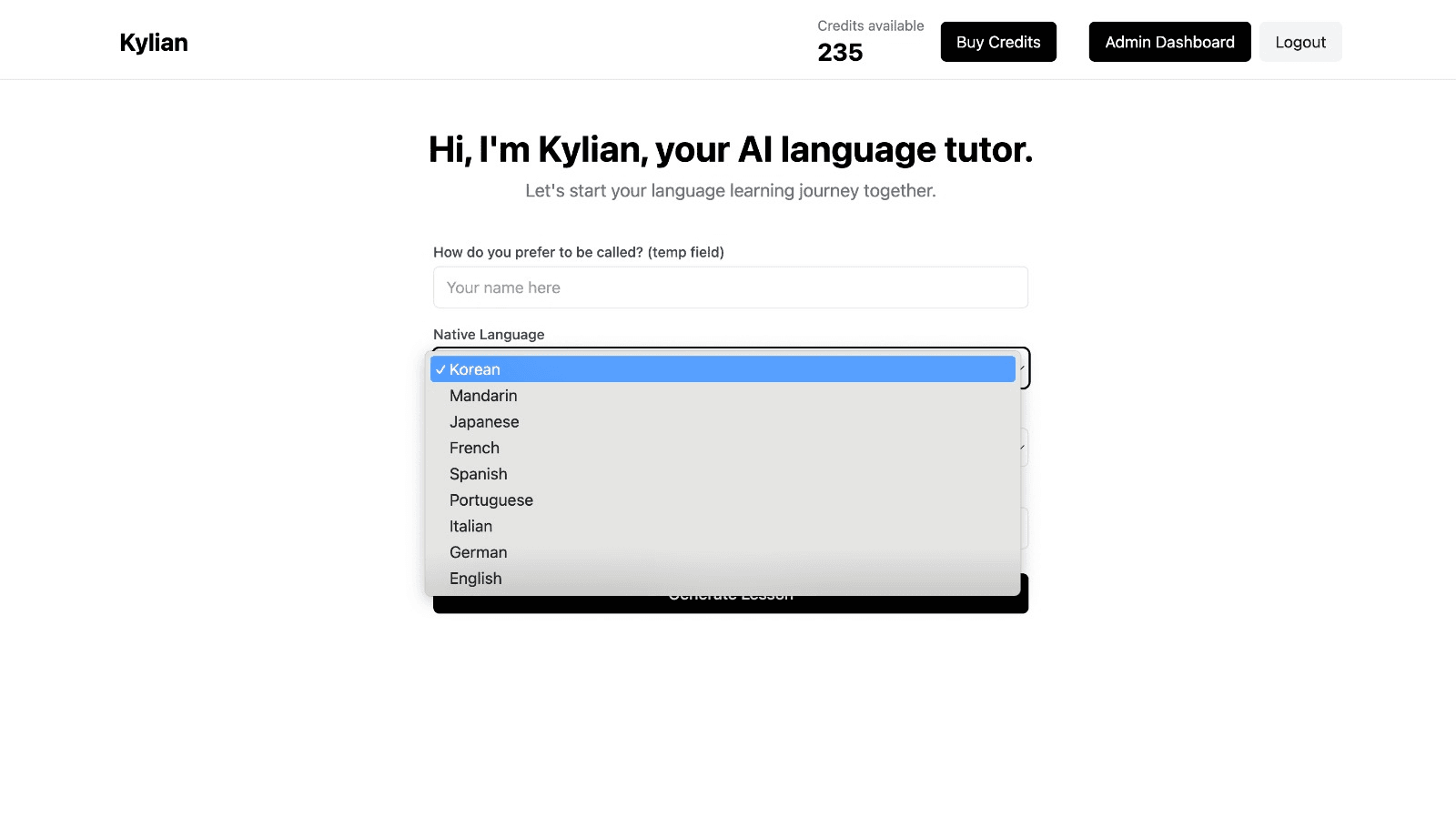
This personalization removes the frustration and confusion that are so common in traditional language learning.
Choose a specific topic you want to learn
Frustrated by language lessons that never cover exactly what you need? Kylian can teach you any aspect of a language—from pronunciation to advanced grammar—by focusing on your specific goals.
Avoid vague requests like “How can I improve my accent?” and be precise: “How do I pronounce the R like a native English speaker?” or “How do I conjugate the verb ‘to be’ in the present tense?”
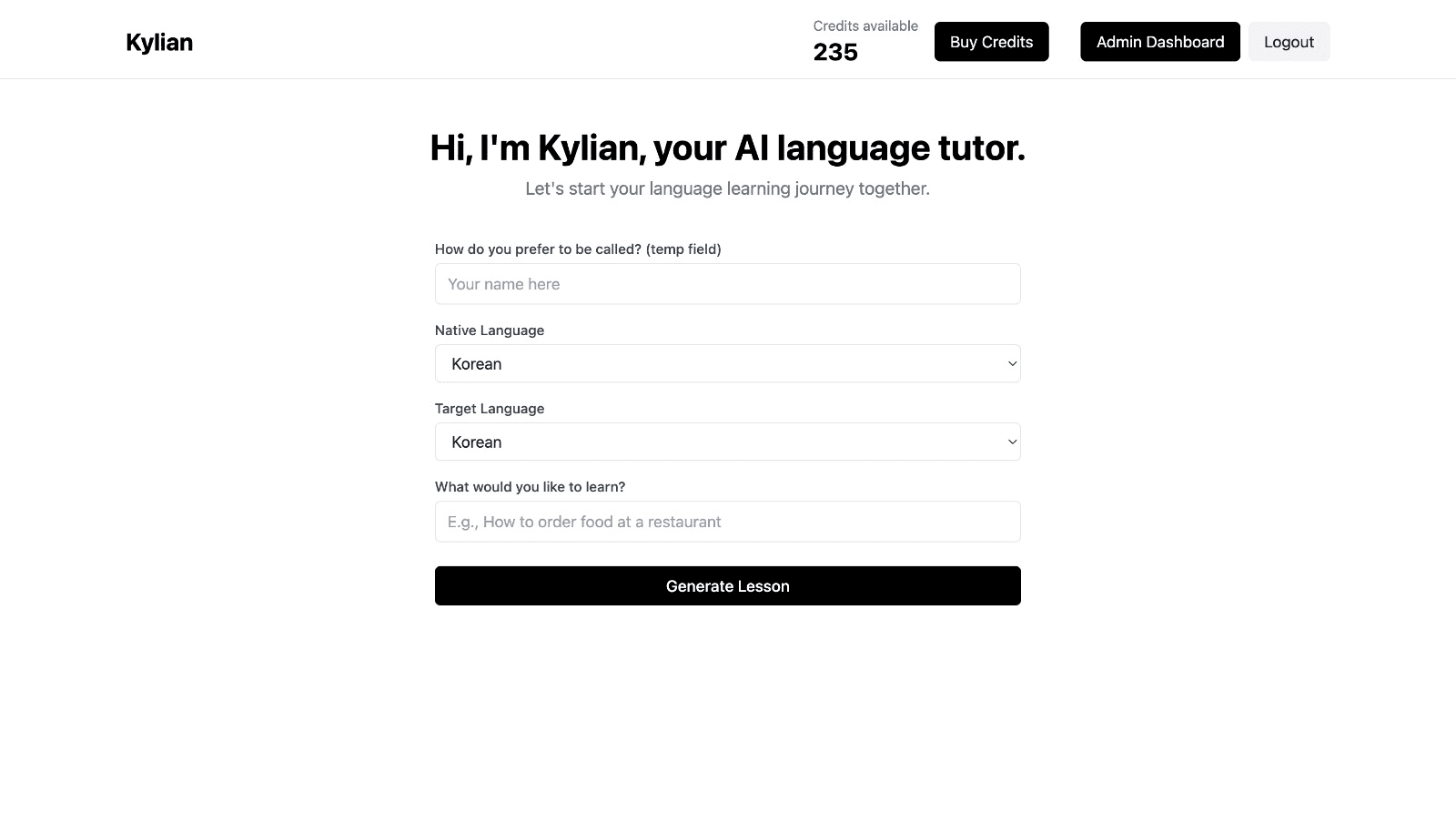
With Kylian, you’ll never again pay for irrelevant content or feel embarrassed asking “too basic” questions to a teacher. Your learning plan is entirely personalized.
Once you’ve chosen your topic, just hit the “Generate a Lesson” button, and within seconds, you’ll get a lesson designed exclusively for you.
Join the room to begin your lesson
The session feels like a one-on-one language class with a human tutor—but without the high price or time constraints.
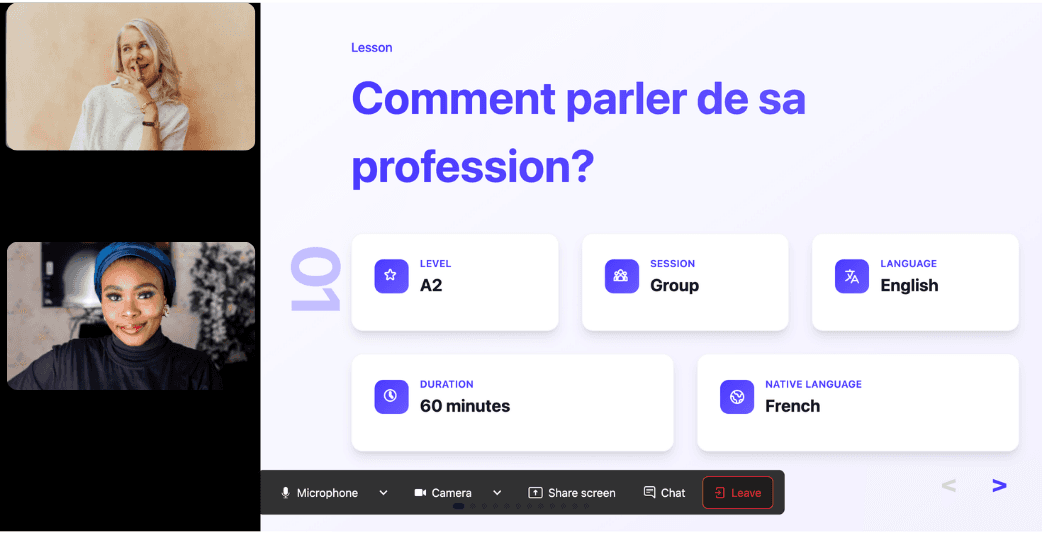
In a 25-minute lesson, Kylian teaches exactly what you need to know about your chosen topic: the nuances that textbooks never explain, key cultural differences between French and your target language, grammar rules, and much more.
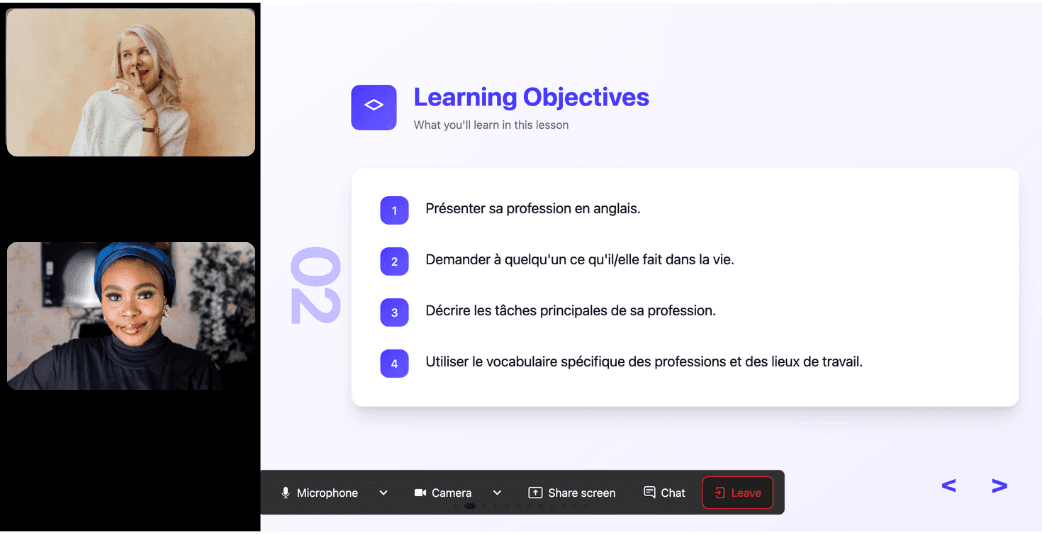
Ever felt frustrated trying to keep up with a native-speaking teacher, or embarrassed to ask for something to be repeated? With Kylian, that problem disappears. It switches intelligently between French and the target language depending on your level, helping you understand every concept at your own pace.
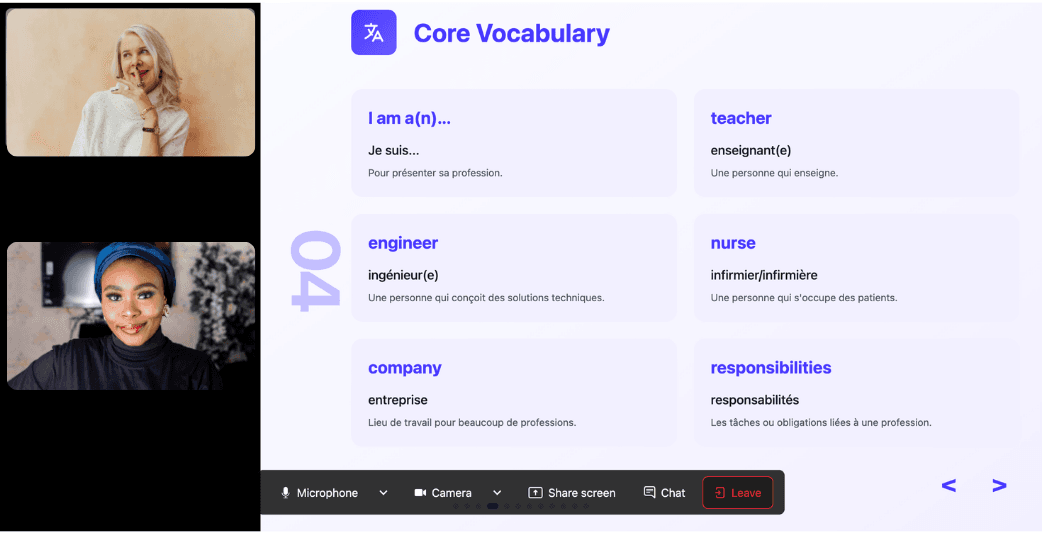
During the lesson, Kylian uses role-plays, real-life examples, and adapts to your learning style. Didn’t understand something? No problem—you can pause Kylian anytime to ask for clarification, without fear of being judged.
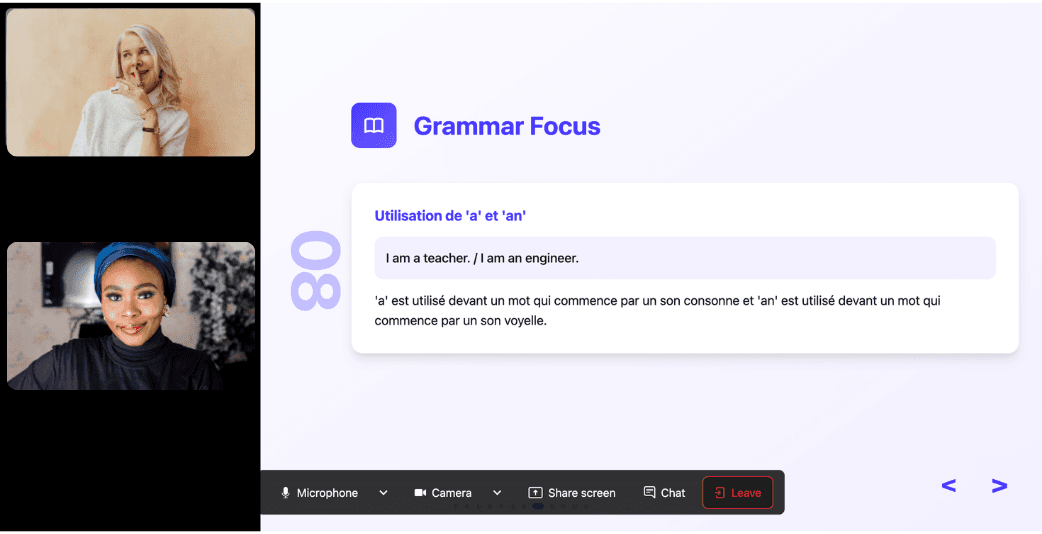
Ask all the questions you want, repeat sections if needed, and customize your learning experience in ways traditional teachers and generic apps simply can’t match.
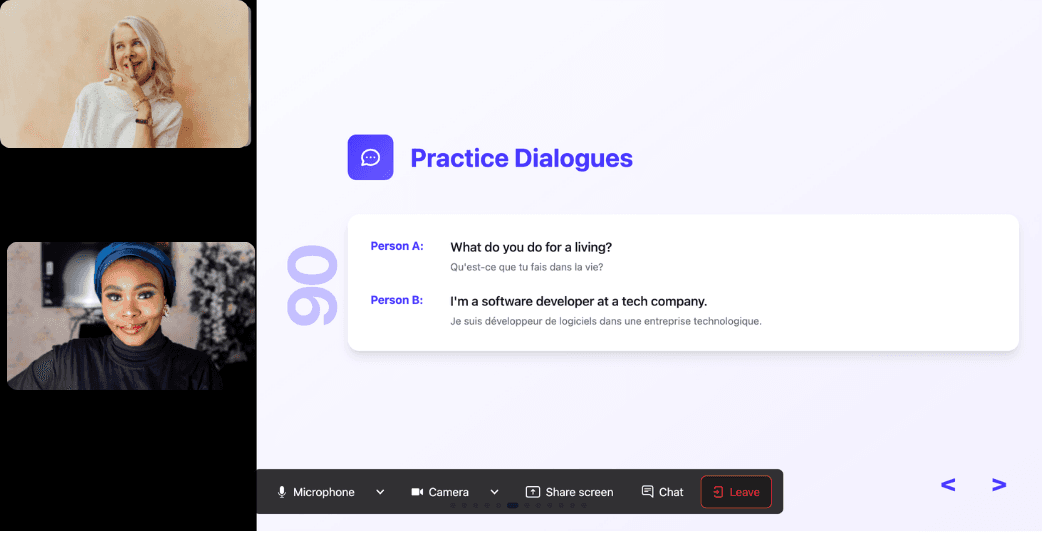
With 24/7 access at a fraction of the cost of private lessons, Kylian removes all the barriers that have kept you from mastering the language you’ve always wanted to learn.
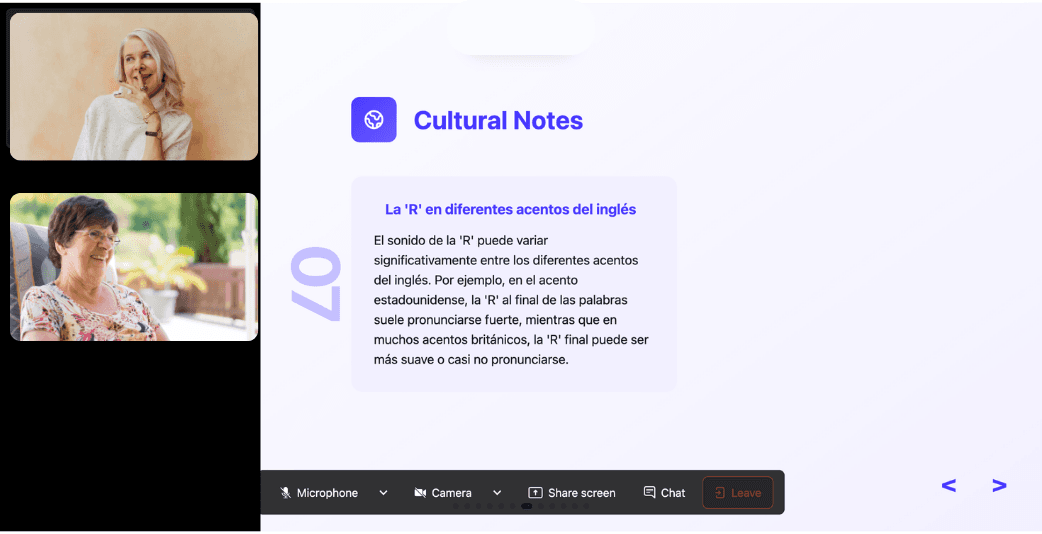
Similar Content You Might Want To Read

What Does FML Abbreviation Mean?
So you encounter native English speakers texting "FML" but remain uncertain about its meaning? Understanding internet slang matters because digital communication now represents 85% of daily interactions among millennials and Gen Z users. FML stands for "F*** My Life" – an expression of frustration, disappointment, or exasperation used when circumstances feel particularly unfavorable. This abbreviation emerged during the early 2000s internet culture and has become embedded in modern English digital communication. Unlike temporary slang that fades within months, FML has maintained consistent usage across platforms for over two decades, making it essential knowledge for anyone navigating contemporary English conversations.

English Abbreviations: Initials Explained Simply
Communication efficiency drives language evolution. Abbreviations—particularly those derived from initials—represent this fundamental linguistic optimization. They compress complex concepts into accessible shorthand, creating linguistic shortcuts that simultaneously accelerate communication and establish insider communities through shared knowledge. The strategic deployment of initial abbreviations transcends mere convenience—it serves as a critical communication tool across professional environments, digital platforms, and evolving social contexts. Understanding these abbreviations constitutes an essential component of modern English fluency. This comprehensive analysis explores how initial abbreviations function within English, examining their structural patterns, contextual applications, and strategic implementation across various domains.

17 Most Common Text Abbreviations in English: Decoded
In today's digitally-driven world, text message abbreviations have become an essential component of modern communication. These shorthand expressions not only streamline our digital conversations but also create a shared linguistic framework among English speakers worldwide. For anyone navigating English-language digital spaces—whether you're learning the language or simply trying to decode what your teenager just sent you—understanding these abbreviations is increasingly vital.

40 Most Memorable British Slang Words ESL Learners Need
Mastering British slang represents a critical milestone for ESL learners seeking authentic communication with native speakers. Unlike textbook English, slang forms the backbone of genuine British conversation, creating bridges between formal language instruction and real-world linguistic competency. British slang operates as more than casual vocabulary—it functions as cultural currency. Each term carries centuries of social evolution, regional identity, and generational wisdom compressed into accessible expressions. For ESL learners, understanding these terms transforms mechanical language use into natural, contextually appropriate communication. The data supports this necessity. Research indicates that native speakers incorporate slang into approximately 60% of informal conversations, making comprehension essential for meaningful social and professional integration. Without this knowledge, ESL learners miss critical communication layers, potentially misinterpreting tone, intent, and social dynamics. This comprehensive guide examines 40 essential British slang terms, organized by usage context and frequency. Each entry provides etymological background, practical applications, and strategic implementation advice for ESL learners pursuing linguistic authenticity.

Dr, MD, PhD: Doctor Abbreviations You Need to Know
Medical professionals earn their titles through years of rigorous education and training. Yet confusion persists about when to use "Dr." versus "MD" or how to properly address different types of doctors in professional settings. Understanding doctor abbreviations matters more than casual etiquette—it reflects professional competency and can impact business relationships, academic collaborations, and patient interactions. Whether you're writing formal correspondence, introducing speakers, or navigating healthcare systems, precision in medical titles demonstrates respect for expertise and institutional protocols.
![What is the abbreviation for yards? [English]](/_next/image?url=https%3A%2F%2Fcdn.sanity.io%2Fimages%2F147z5m2d%2Fproduction%2F4079cd1014fbfe6e6358690419279de3cf570825-2240x1260.png%3Frect%3D175%2C0%2C1890%2C1260%26w%3D600%26h%3D400&w=3840&q=75)
What is the abbreviation for yards? [English]
The standard abbreviation for yards is "yd." When measuring distances, particularly in countries using the imperial system, this two-letter abbreviation represents the unit of length equal to three feet or 36 inches. Understanding this abbreviation is essential for accurate communication in various contexts, from sports and construction to fabric purchasing and everyday measurements.